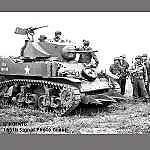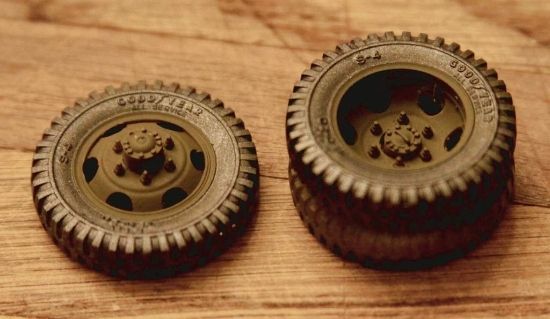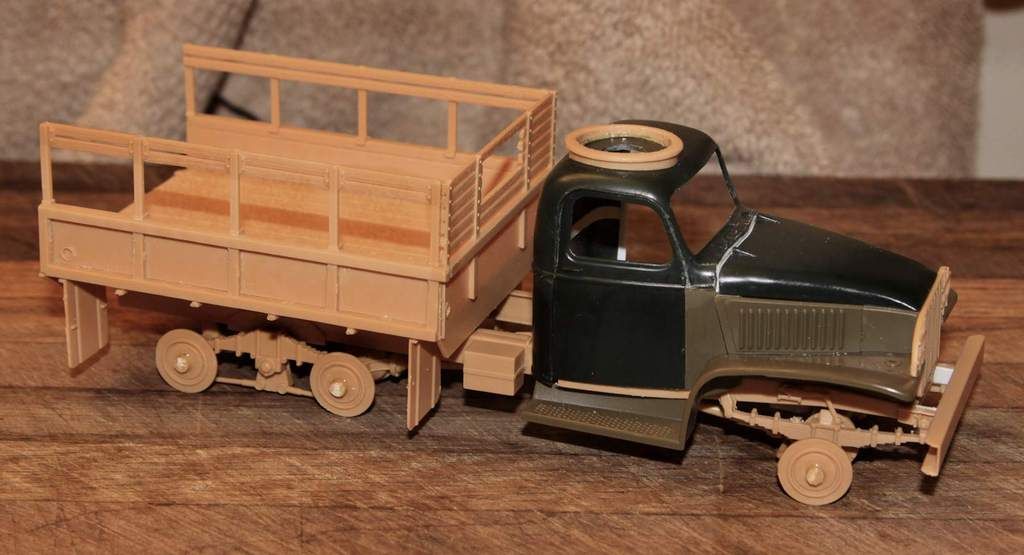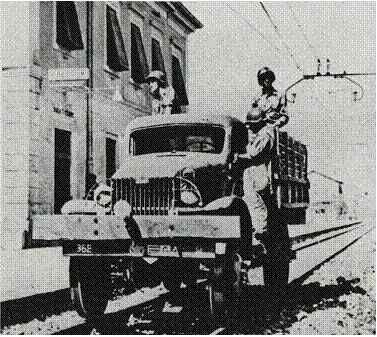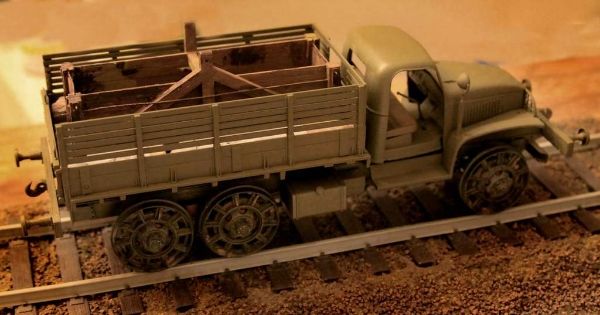Yes Alvaro, I went with the resin wheels in order to get the raised lettering.
I think they look nice. I just hope the rest of my build can live up to their high quality.
Armor/AFV
For discussions on tanks, artillery, jeeps, etc.
For discussions on tanks, artillery, jeeps, etc.
Hosted by Darren Baker, Mario Matijasic
Waiting for a new Deuce and a Half
Posted: Thursday, May 26, 2016 - 06:02 AM UTC
alewar

Joined: December 27, 2006
KitMaker: 773 posts
Armorama: 765 posts

Posted: Thursday, May 26, 2016 - 08:32 AM UTC
I agree. They are Def or Panzer Art? .
Álvaro
Álvaro
Posted: Thursday, May 26, 2016 - 08:33 AM UTC
Posted: Thursday, May 26, 2016 - 06:10 PM UTC
They are the Def. wheels - very nice castings (no air bubbles) except a bit difficult to mount true and square to the frame.
The problem is they cast only three types of wheels instead of four:
Spares x2, Front x2, and Rear x8.
The inside rear wheel castings are identical to the outside real wheels. You therefore have lug nuts on the inside wheel castings to remove. This makes it rather difficult to prepare a flat surface to super glue the kit brake drum to. Also there is nothing to help you center the brake drum on the wheel other than doing it by eye.
Painting the wheels now - photos to follow.
The problem is they cast only three types of wheels instead of four:
Spares x2, Front x2, and Rear x8.
The inside rear wheel castings are identical to the outside real wheels. You therefore have lug nuts on the inside wheel castings to remove. This makes it rather difficult to prepare a flat surface to super glue the kit brake drum to. Also there is nothing to help you center the brake drum on the wheel other than doing it by eye.
Painting the wheels now - photos to follow.
Posted: Friday, May 27, 2016 - 08:29 AM UTC
Posted: Monday, May 30, 2016 - 10:43 PM UTC
Here is a question that loosely relates to three axle trucks:
I have often heard that the Russians took captured German trucks and sometimes added a third axle (probably unpowered) to increase load capacity. However I have never seen any photos or other documentation on this subject.
Anyone out there have something on this topic?
Frenchy???
I have often heard that the Russians took captured German trucks and sometimes added a third axle (probably unpowered) to increase load capacity. However I have never seen any photos or other documentation on this subject.
Anyone out there have something on this topic?
Frenchy???
M4A1Sherman

Joined: May 02, 2013
KitMaker: 4,403 posts
Armorama: 4,078 posts

Posted: Monday, May 30, 2016 - 11:33 PM UTC
Quoted Text
I am probably going about this the hard way . . . everything in dark plastic is from Italeri, everything in olive drab is Tamiya and finally, what appears in tan plastic is from HobbyBoss.
I went with the Tamiya parts because they seemed to take a bit less modification than the Italeri fenders but if I had to do it all over I would stay with just the Italeri and HobbyBoss parts.
Hi, Mike! I think this is probably the way I'll fly with my future CCKW352/CCKW353 builds: kit-bashes of the ITALERI/HOBBY BOSS kits, ABER PE sets, DEF Sagged Wheel/Tire assemblies, ARCHER Dashboards & Placards and ARCHER National Insignia, Serials and Bumper Codes...

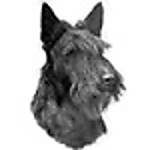
Frenchy

Joined: December 02, 2002
KitMaker: 12,719 posts
Armorama: 12,507 posts

Posted: Monday, May 30, 2016 - 11:41 PM UTC
Quoted Text
I have often heard that the Russians took captured German trucks and sometimes added a third axle (probably unpowered) to increase load capacity. However I have never seen any photos or other documentation on this subject.
Anyone out there have something on this topic?
Frenchy???
I haven't seen such modification either. But I must admit I haven't seen a lot of pics showing German trucks in Red Army service

A few examples here : http://www.vetrabotnik.narod.ru/Texts/TWW/USSR/Panzer/T011.htm
H.P.
M4A1Sherman

Joined: May 02, 2013
KitMaker: 4,403 posts
Armorama: 4,078 posts

Posted: Tuesday, May 31, 2016 - 12:11 AM UTC
Quoted Text
Here is a question that loosely relates to three axle trucks:
I have often heard that the Russians took captured German trucks and sometimes added a third axle (probably unpowered) to increase load capacity. However I have never seen any photos or other documentation on this subject.
Anyone out there have something on this topic?
Frenchy???
Hi, Mike- In looking through my GREAT Schiffer "Trucks of the Wehrmacht" book by Reinhard Frank, I see that the Germans really didn't have to resort to adding a third axle to their own and/or captured two-axle trucks; they had enough three-axle trucks of their own, and of the ones that they had captured, too:
Einheits Diesels made by several domestic manufacturers, the three-axle Mercedes G3s, 9-ton FAUN L 900s, various Henschell Typ 33s, and Krupp's Protze and L 3 H 63 trucks, and some Magirus three-axle types for example, and of course, their various Vomag 9-tonners.
As far as captured (by the Germans) three-axle trucks go, there were the Steyr 640s, Austro-Daimler ADGRs, Czech-Skoda Hs, various Tatras, such as the T 81, T 85, T 92, Crossley JGL 8, various three-axle Scammells, and of course, the Soviet Gaz AAAs, which were license-built Ford AAAs, captured "Lend-Lease" US-6 Studebakers, and captured US CCKW352 and CCKW353 Jimmies, in various forms. Quite possibly, the Soviets didn't have to resort to adding a third axle to different two-axle trucks, either. We know for a fact that the Soviets captured MOUNTAINS of German vehicles, AFVs and military equipment of all kinds.
The US sent the Russians, under Lend-Lease, (for which they NEVER paid us back) TENS of THOUSANDS of Studebaker US-6s, Internationals and a goodly number of CCKW-series trucks, and I'm sure that some heavier types (Autocars, Whites, Diamond-Ts, FWDs, American-La France and Mack Nos, for example)- The Russians also had their own Zil and Zis Three-axle trucks.
Hope this helps to answer your question; I'm sure that Frenchy can add some more input or commentary to this short list...

Posted: Tuesday, May 31, 2016 - 01:13 AM UTC
Thanks Dennis for all the great info. I guess the idea that the Russians converted some trucks is just a myth. Why would they need to????
alewar

Joined: December 27, 2006
KitMaker: 773 posts
Armorama: 765 posts

Posted: Tuesday, May 31, 2016 - 02:15 AM UTC
Thanks Michael for the data about the wheels.

Álvaro

Álvaro
hmgroth

Joined: October 06, 2007
KitMaker: 4 posts
Armorama: 4 posts

Posted: Tuesday, May 31, 2016 - 03:02 AM UTC
Michael, any chance of seeing a pic of the underside of your RR conversion? I'm interested in the placement of the I-beams added for strength and stability. Thanks!
Mark
Mark
Posted: Tuesday, May 31, 2016 - 06:18 AM UTC
Mark, here ya go:

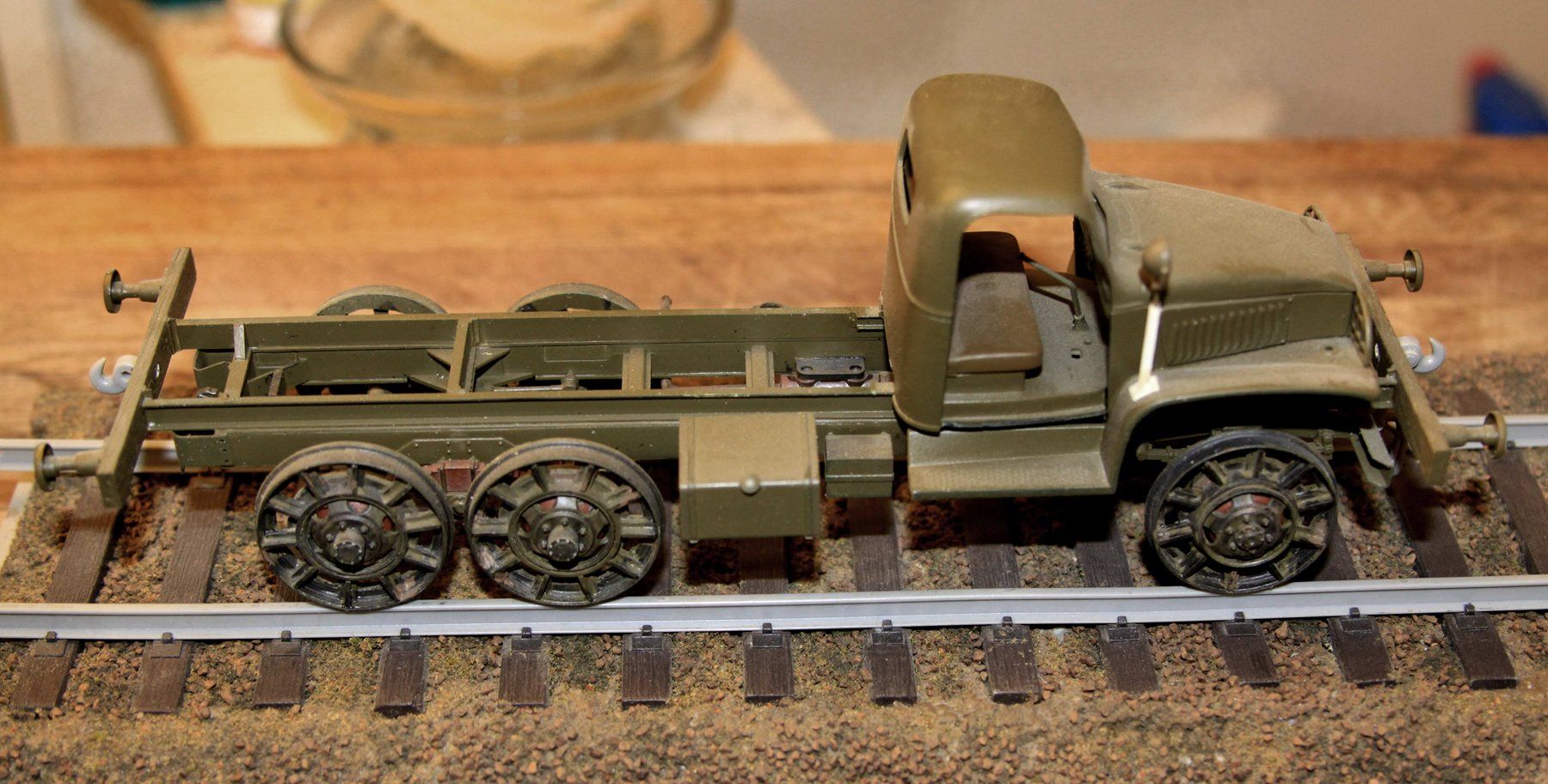
This is my own design. It is not based on any military references. I can't tell you for certain that any of the GMC's were actually converted in this way. To me it is simply logical. The end beam of the standard European freight car was considerably higher than the level of the GMC frame even after it was raised by the large diameter rail wheels. I felt the end beams on this GMC had to be supported by something more than just angle brackets bolted to the truck frame.
I have spent some time around operating railroad museums. Everyday switching duties of a small engine handling one or two cars, would take more pounding than the standard deuce truck frame could ever endure. I felt it had to be reenforced with something more substantial.


This is my own design. It is not based on any military references. I can't tell you for certain that any of the GMC's were actually converted in this way. To me it is simply logical. The end beam of the standard European freight car was considerably higher than the level of the GMC frame even after it was raised by the large diameter rail wheels. I felt the end beams on this GMC had to be supported by something more than just angle brackets bolted to the truck frame.
I have spent some time around operating railroad museums. Everyday switching duties of a small engine handling one or two cars, would take more pounding than the standard deuce truck frame could ever endure. I felt it had to be reenforced with something more substantial.
Posted: Tuesday, May 31, 2016 - 06:29 AM UTC
Posted: Tuesday, May 31, 2016 - 06:41 AM UTC
Posted: Tuesday, May 31, 2016 - 06:50 AM UTC
hmgroth

Joined: October 06, 2007
KitMaker: 4 posts
Armorama: 4 posts

Posted: Tuesday, May 31, 2016 - 07:23 AM UTC
Thanks, Mike... exactly what I was looking for!
Mark
Mark
tanknick22

Joined: February 19, 2009
KitMaker: 1,139 posts
Armorama: 1,100 posts

Posted: Saturday, June 04, 2016 - 05:09 PM UTC
Quoted Text
Well, GEE... There were only 40,000 or so Shermans built during WWII- How many German tanks were built from 1935 to 1945? I say bring on any and all variants of the M4-series!!!
according to wikipedia there 56773 shermans of all models produced

KurtLaughlin

Joined: January 18, 2003
KitMaker: 2,402 posts
Armorama: 2,377 posts

Posted: Saturday, June 04, 2016 - 05:38 PM UTC
Quoted Text
according to wikipedia there 56773 shermans of all models produced
There were 49,234 M4 series tanks built, allowing for a handful of production pilots or severely altered chassis that may not have been officially accepted.
Interestingly, the Wikipedia page also says 49,234 in the summary but includes a tabulation that totals 56,773. That alone should be a good indicator of the need for a critical review of such data before repeating it.
KL
Posted: Sunday, June 05, 2016 - 04:49 AM UTC
Shermans on a Deuce and a Half blog??????? Oh well. that's cool.
Posted: Sunday, June 05, 2016 - 04:55 AM UTC
Mark, your questions have me working again on my CCKW Locomotive. A question for you: do you think the judges will figure out that when the guys went looking for scrap metal to weigh down their locomotive there was a stone cutters bone yard right next to that scrap yard?
I will be filling that gondola with scrap metal but the old stone gateposts will be there as well.
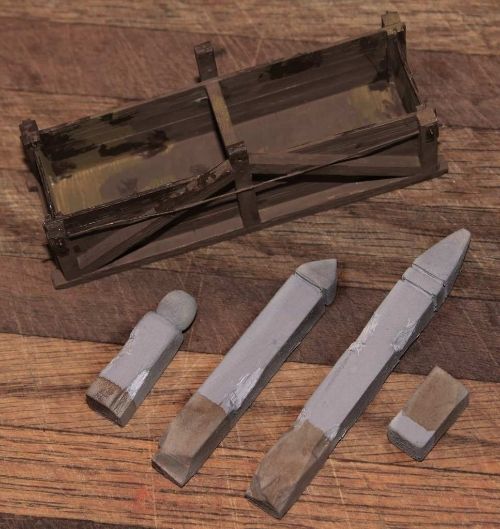
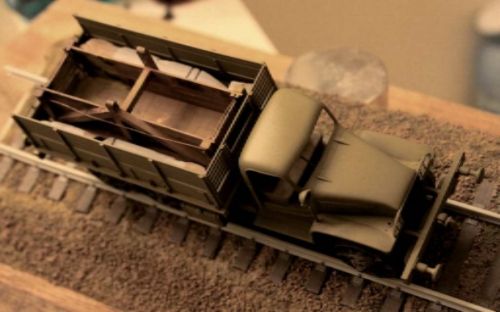
I will be filling that gondola with scrap metal but the old stone gateposts will be there as well.


hmgroth

Joined: October 06, 2007
KitMaker: 4 posts
Armorama: 4 posts

Posted: Sunday, June 05, 2016 - 07:46 PM UTC
Great idea with the gondola and with the stone--it'll really set your model apart from the others!
I imagine they filled the cargo area with whatever weighty junk was at hand. I was wondering myself what to throw in there besides the six tires and wheels--maybe a rusted engine and drive shaft parts from my left-over GMCs
I'll try to add a pic of my progress later.
Mark
I imagine they filled the cargo area with whatever weighty junk was at hand. I was wondering myself what to throw in there besides the six tires and wheels--maybe a rusted engine and drive shaft parts from my left-over GMCs

I'll try to add a pic of my progress later.
Mark
Posted: Sunday, June 05, 2016 - 08:04 PM UTC
One of my first thoughts was to fill up the gon with the many Sherman and Panzer parts in my spares box. Then it occurred to me these make-shift locomotives were used during the supply build up prior to D-Day. Therefore there would be very few "scrap parts" available from damaged Shermans and NO Panzer parts.
Right now my thoughts are turning more to old steam RR Locomotive drivers, connecting rods, etc.
A rusty old GMC engine is a great idea!
Right now my thoughts are turning more to old steam RR Locomotive drivers, connecting rods, etc.
A rusty old GMC engine is a great idea!
Posted: Tuesday, June 07, 2016 - 01:21 AM UTC
COMPARISON REPORT: The Italeri vs. the Peerless Max Deuce and a half kits:

Often I see modelers (myself included) making the assumption that Italeri simply bought the molds from Peerless Max on the deuce, re-boxed it and continued to produce the venerable truck kit totally unchanged.
Well I am now in a position to say definitively that this concept is totally incorrect!
Knowing that I am one modeler who is totally overboard about doing Deuce conversions, a good buddy of mine gave me two elderly but as yet unopened, CCKW gun truck kits, one from Italeri and one, much older, from Peerless Max.
One of the first things that came to my mind was the chance to finally compare the two kits side by side to see if they are identical. Which they certainly are not!
Right off the bat I discovered that the Peerless GMC runs on the Banjo style differentials and not the much more common split diff's like the Italeri kit portrays. The transfer case on the Peerless kit is correctly of a different design style that matches GM's use on the Banjo diff's. Also interestingly enough the Peerless kit employs a cast "all as one piece" frame much like the modern day Tamiya Deuce though the Peerless frame has been done in a slightly more heavy handed manor. As everyone probably already knows the later Italeri model provides a proper, multi-piece "C" Channel ladder frame that in my mind beats out even Tamiya's current offering for detail. (A bit harder to build, yes, but much more realistic in detail and interestingly it matches the way HobbyBoss chose to do their ladder fame in their very recent new Deuce offering.)
Neither kit includes an engine but the engine oil pan of the Peerless model is cast into the frame. Whereas the engine oil pan on the Italeri kit is molded between the fenders and then is applied to the frame which gives a bit more of a 3D appearance to the underbody. Also even without an engine in either truck the older Peerless kit still gives you a separate hood just in case you want to scratch build an engine!
The body of the cab is pieced out differently on the two kits with the Peerless giving the modeler one more seam to try and disguise. Also the hole is the cab roof for the machine gun is handled differently between the two kits. The Peerless cab attempts to serve double duty for both the machine gun and cargo trucks alike. I am told that in building the straight Peerless cargo truck it is impossible to sand smooth the stress lines in the roof that tell the modeler where to cut out for the roof access hole on the gun truck.
The Peerless kit offers actual rubber tires on nicely done plastic wheel drums. I know many would prefer a cast tire but in this case I feel the Italeri cast wheels and tires are undersized so the Peerless kit wins out here for the more correctly sized tires.
Of note; I plan on holding on to the Peerless kit if for no other reason than that I will have a set of the more rare Banjo differentials to use on some conversion in the future!
Regards

Often I see modelers (myself included) making the assumption that Italeri simply bought the molds from Peerless Max on the deuce, re-boxed it and continued to produce the venerable truck kit totally unchanged.
Well I am now in a position to say definitively that this concept is totally incorrect!
Knowing that I am one modeler who is totally overboard about doing Deuce conversions, a good buddy of mine gave me two elderly but as yet unopened, CCKW gun truck kits, one from Italeri and one, much older, from Peerless Max.
One of the first things that came to my mind was the chance to finally compare the two kits side by side to see if they are identical. Which they certainly are not!
Right off the bat I discovered that the Peerless GMC runs on the Banjo style differentials and not the much more common split diff's like the Italeri kit portrays. The transfer case on the Peerless kit is correctly of a different design style that matches GM's use on the Banjo diff's. Also interestingly enough the Peerless kit employs a cast "all as one piece" frame much like the modern day Tamiya Deuce though the Peerless frame has been done in a slightly more heavy handed manor. As everyone probably already knows the later Italeri model provides a proper, multi-piece "C" Channel ladder frame that in my mind beats out even Tamiya's current offering for detail. (A bit harder to build, yes, but much more realistic in detail and interestingly it matches the way HobbyBoss chose to do their ladder fame in their very recent new Deuce offering.)
Neither kit includes an engine but the engine oil pan of the Peerless model is cast into the frame. Whereas the engine oil pan on the Italeri kit is molded between the fenders and then is applied to the frame which gives a bit more of a 3D appearance to the underbody. Also even without an engine in either truck the older Peerless kit still gives you a separate hood just in case you want to scratch build an engine!
The body of the cab is pieced out differently on the two kits with the Peerless giving the modeler one more seam to try and disguise. Also the hole is the cab roof for the machine gun is handled differently between the two kits. The Peerless cab attempts to serve double duty for both the machine gun and cargo trucks alike. I am told that in building the straight Peerless cargo truck it is impossible to sand smooth the stress lines in the roof that tell the modeler where to cut out for the roof access hole on the gun truck.
The Peerless kit offers actual rubber tires on nicely done plastic wheel drums. I know many would prefer a cast tire but in this case I feel the Italeri cast wheels and tires are undersized so the Peerless kit wins out here for the more correctly sized tires.
Of note; I plan on holding on to the Peerless kit if for no other reason than that I will have a set of the more rare Banjo differentials to use on some conversion in the future!
Regards
Posted: Wednesday, June 08, 2016 - 03:34 AM UTC
 |




